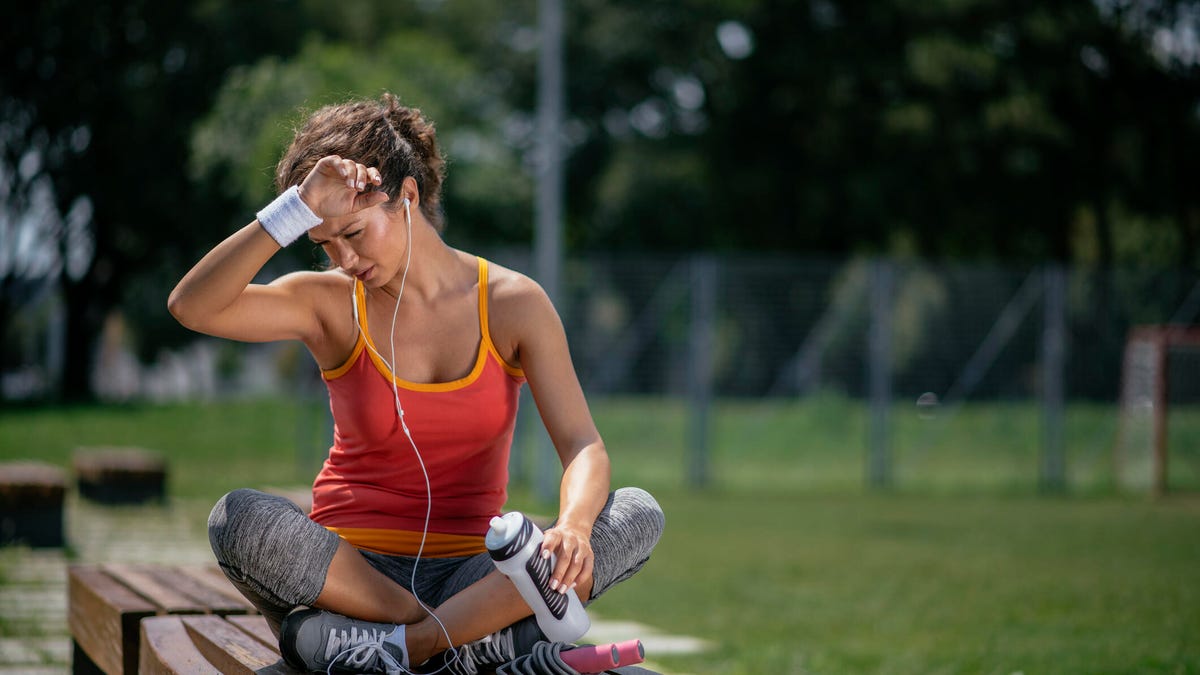
Summer is one of the best times to get active outdoors. But as pleasant as the sunshine may feel, there are some precautions you have to take for the heat. Just like winter requires you to layer up, the summer has its own challenges, and it’s important to be safe if you’re spending a lot of time outdoors.
The last thing you want to do is experience heat exhaustion or heat stroke because you didn’t prepare accordingly. Stay safe with these tips if you enjoy going for long walks, runs, hikes or bike rides.
Stay hydrated
It sounds obvious, but prioritizing hydration is important to stay healthy outdoors on hot days. In fact, you should take it a step further and infuse your water with electrolytes or swap it for a sports drink. Electrolytes help you replenish minerals lost through sweat. That’s why water alone is not enough if you’re exercising outdoors in the heat. “Exercising raises your core temperature and it is through perspiration that the body can manage and mitigate the heat that is generated,” said Joy Puleo, certified personal trainer and Balanced Body education program manager. She added that in hot and humid weather, this natural cooling mechanism may not work as efficiently.
Karen Hoch, a Road Runners Club of America run coach, said if you’re planning on doing a vigorous activity such as running, you should hydrate well the day before using electrolytes. “When you wake up in the morning, drink room temperature water and continue sipping water, and again add electrolytes until 30 minutes before your run,” she explained. While you’re out and about, she suggests carrying water with electrolytes and bringing money in case you need to refill along the way.
Dress accordingly
When exercising in any season, a good rule of thumb is dressing for the weather. Wearing a lightweight hat is a good way to keep your face covered, and wearing sunglasses protects your eyes from the sun. When it’s hot, it’s best to wear minimal and light-colored clothing (dark colors retain heat) to avoid overheating. Also, it’s best to stick to moisture-wicking material or synthetic fabrics such as nylon since it breathes better than cotton, which doesn’t dry fast enough.
These will also help prevent chafing, which is common in the summer and is caused by constant friction from skin-on-skin or skin-on-clothing rubbing. If you tend to chafe, make sure to lubricate the prone areas with petroleum jelly, a balm (such as Body Glide) or even popular drugstore moisturizers such as Aquaphor or Cerave.
Read more: Summertime Workouts That Are Great for the Outdoors
Go out early or later in the day
The time of day you choose to exercise outdoors can make or break your workout. Stick to early morning or late evening hours after the sun has set. “Avoid activity outside between 10 a.m. and 3 p.m. because it’s considered as the hottest part of the day,” said Daniel Maman, a personal trainer at My Phenom Fitness. Being outdoors during these times for a prolonged time puts you at risk of heat exhaustion.
If you must go out during peak hours…
If you have to be outdoors during the hottest time of day, be extra prepared. Mario Musa, a certified tennis instructor, suggests slowly acclimating yourself to the heat. “By gradually increasing your time outdoors over a period of several days, this will give your body time to adjust to the hotter temperatures,” he said.
You should always wear sunscreen when you go outside, but you should be even more diligent about it if you plan on being out during peak hours. Choose a sunscreen with SPF 30 or higher with broad spectrum protection against UVA and UVB rays. If you aren’t sure what type to buy, CNET has a list of the best sunscreens on the market that are a good place to start. Hoch says if you’re planning on running to find a shady route and scale back the intensity of your run. “I always recommend staying in your aerobic zone as well, which translates to running at an easy conversation pace.”
It gets dangerous to be outside for too long when the temperature hits a heat index of 91 degrees or higher, so make sure to have ample water with you. You should also be mindful of the signs of heat exhaustion or heat stroke. Signs of heat exhaustion include:
- Heavy sweating
- Fast or weak pulse
- Nausea or vomiting
- Muscle cramps
- Dizziness
- Tiredness or weakness
- Headache or fainting
If you exhibit any of these symptoms, it’s important to try and cool down as soon as possible. However, if you’re vomiting, it’s best to go to the hospital for an evaluation by a doctor.
Takeaway
It’s normal to want to enjoy the summer days as much as possible. Many of those days may involve high temperatures, but as long as you’re prepared, you can enjoy them safely. Make sure to dress accordingly, stay hydrated, choose shade whenever possible, and listen to your body if you start to feel ill. Staying cool and comfortable will make even the hottest days easy to handle.


